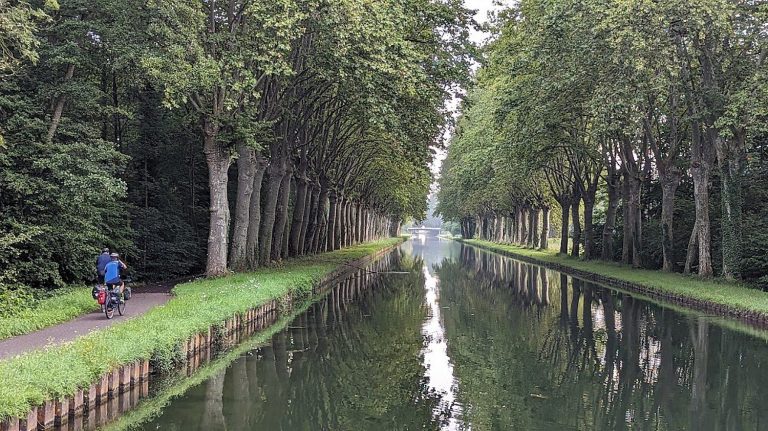
By Karen Rubin, Travel Features Syndicate, goingplacesfarandnear.com
Day 2 Krafft to Strasbourg
Our first morning cruising the canals of France’s Alsace-Lorraine aboard European Waterways’ luxury barge hotel, Panache, takes us from Krafft on the Canal de la Marne au Rhin toward Strasbourg. The route brings us through a spectacularly picturesque allee of trees that apparently dates back to the time of Napoleon. The landscaping of this avenue of trees is a straight line with the trees uniform in shape. You have the feeling of floating through Impressionist paintings – it is so exquisitely beautiful, especially with the morning light creating an ethereal tableau.
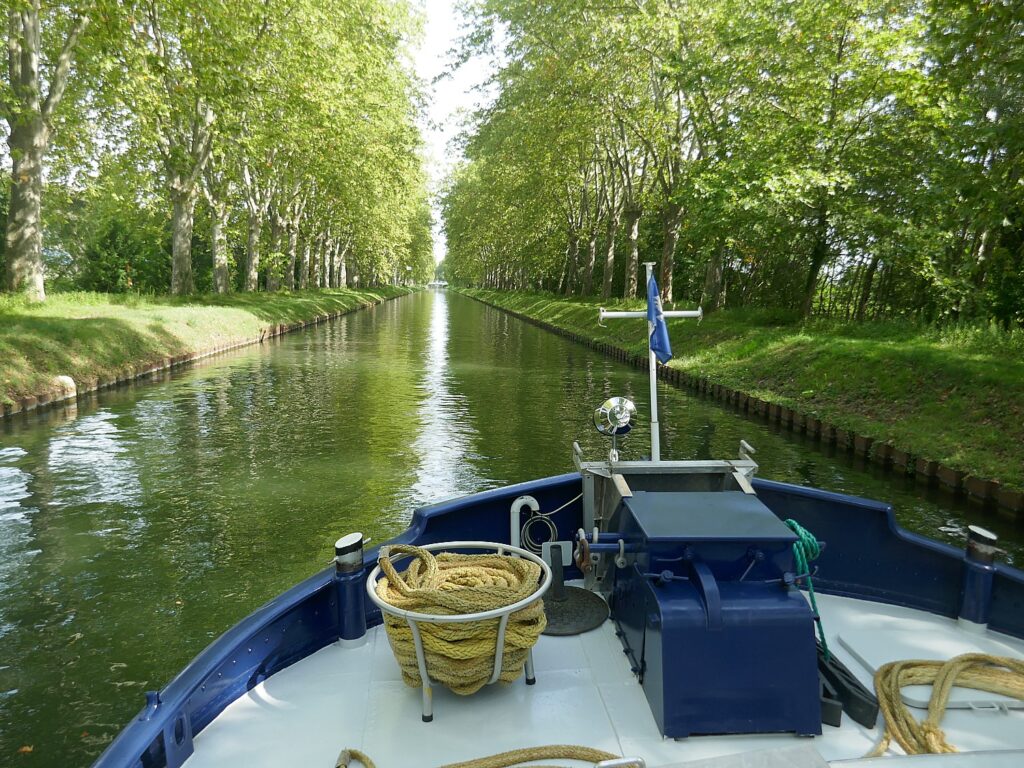
We cruise through locks 81 to 85. A towpath along the canal has been repurposed for biking and walking and I immediately set out to ride. Captain Brian readies the bikes and puts it on the bank for us – it doesn’t take long to get the hang of stepping on or off the boat as it lifts up or down in the lock. (I quickly learn by mistake to watch the signs that tell you when to cross over the canal to stay on the path.)
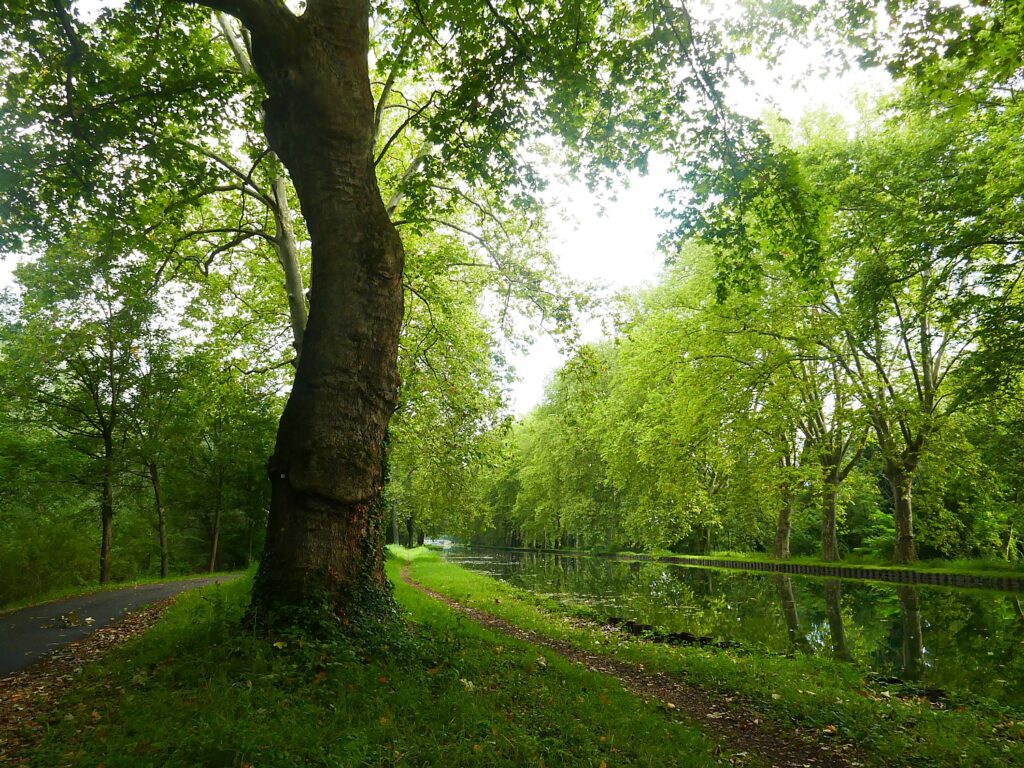
I soon realize that I bike three times as fast as the boat travels, especially since it also spends time going through various locks, so I can enjoy biking the route, then riding back to a lock as the boat approaches, and get to see the scenery all over again from the perspective of the boat’s sundeck (also, it is usually lunch time – don’t want to miss that).
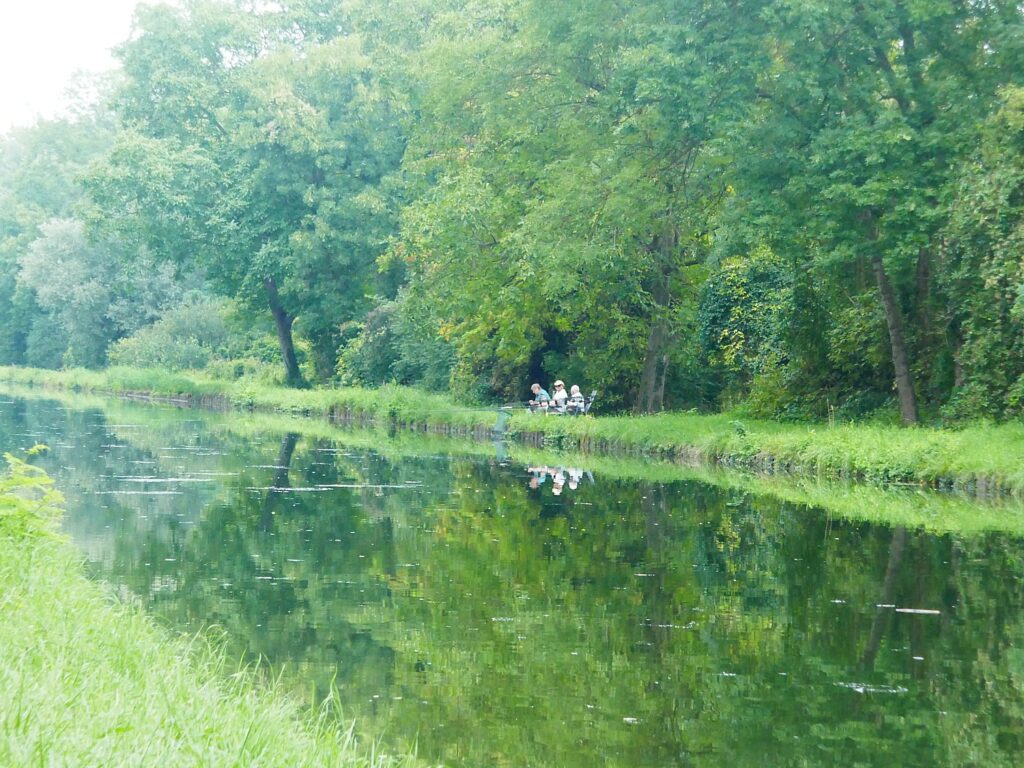
Lunch this first day is a salad of beet root and goat cheese; chicken with a moelle sauce and polenta, served with Saint Romain Chardonnay from Burgundy and La Baronne Alaric (2014), a Syrah blend from the south of France. The cheeses we get to experience include a cow’s milk blue cheese made from a 1200-year old recipe from Auvergne; a Reblochon from Savoie, made from raw cow milk and aged (not pasteurized) for 6-8 weeks.
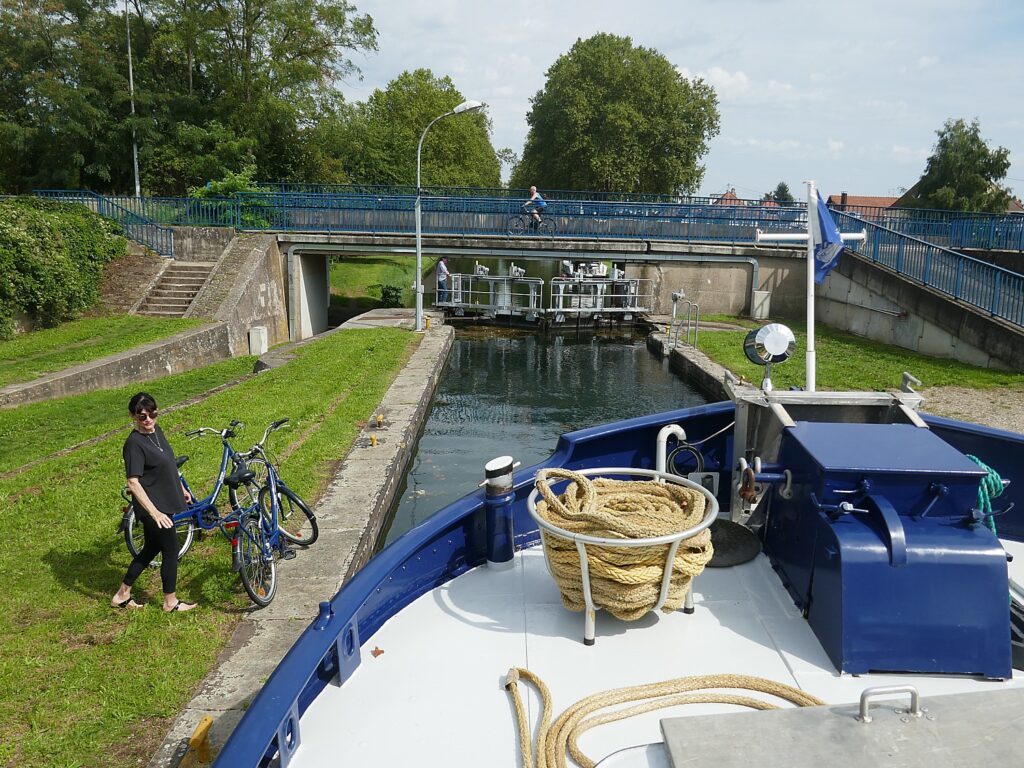
We arrive at Strasbourg, where we tie up at a canal at the outer ring of the historic center, Le Petit France, and walk off the boat to explore on our own before meeting up at Le Pont du Corbeau for a walking tour guided by Captain Brian. (I get lost and after getting directions from a local woman, am staring down at my phone when I hear my name as I am literally walking passed our group waiting at the bridge.)
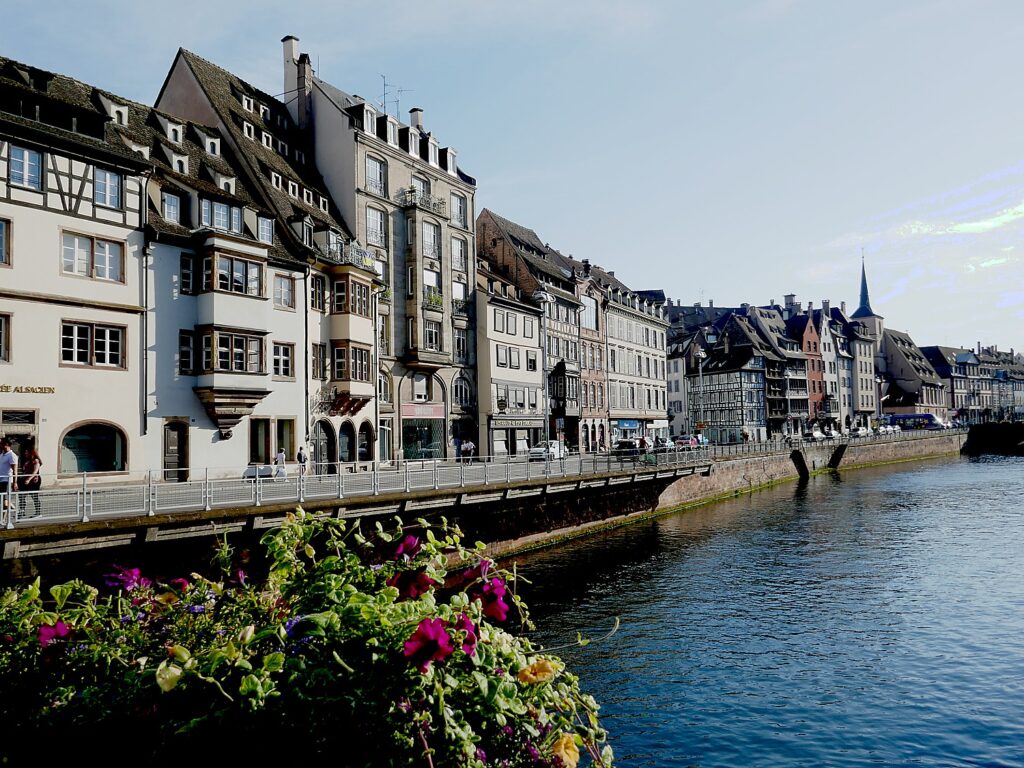
Le Pont du Corbeau was originally called the Schindbrucke (Bridge of Tortures): a law from 1411 that specified that anyone sentenced to death be sewn up inside a linen sack and thrown into the river – a practice which continued until 1617. From 1466 onwards, thieves were locked up in a cage on the bridge to be mocked by passersby before being thrown into the River Ill to swim for their lives. In 1502, a stone crucifix was affixed to the beams of the bridge for people convicted of crimes to repent their acts.
I had already had a couple of days in Strasbourg to explore on my own, but really enjoy Captain Brian’s narration.
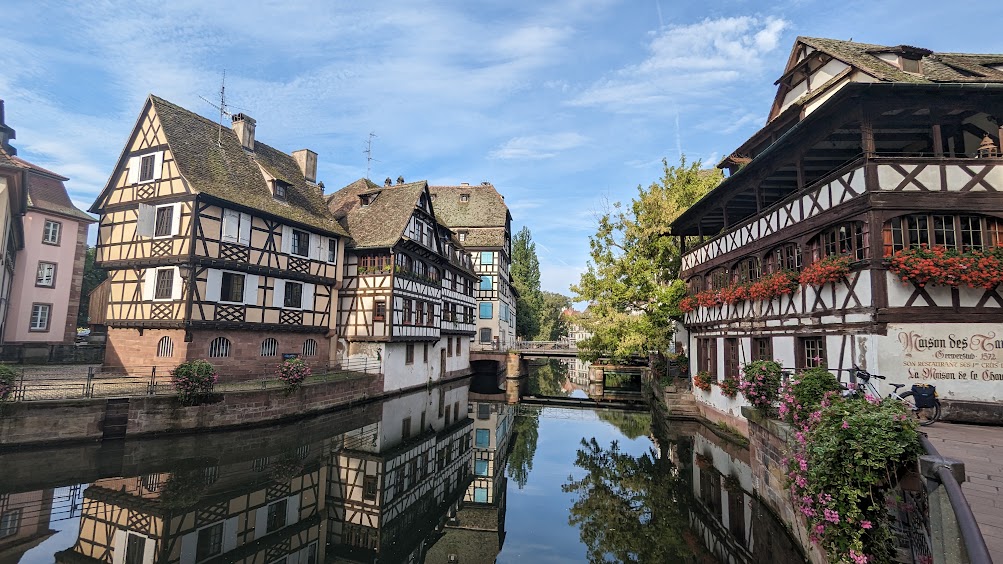
We walk through Le Petit France, the section we find so charming and picturesque with its painted houses with wood beams, floral arrangements, and immaculate streets. But Captain Brian notes, before the 18th century, this district would have been the poorest, stinkiest part of town, populated with fishermen, tanners and animals. The structures would have been made with wood beams coated with a varnish made of a mixture of blood and vinegar (“it looks good but stinks”); waste would have been thrown directly into the canal. The closer to the Cathedral, though, the richer you likely would be – the Chamber of Commerce is located a stone’s throw away.
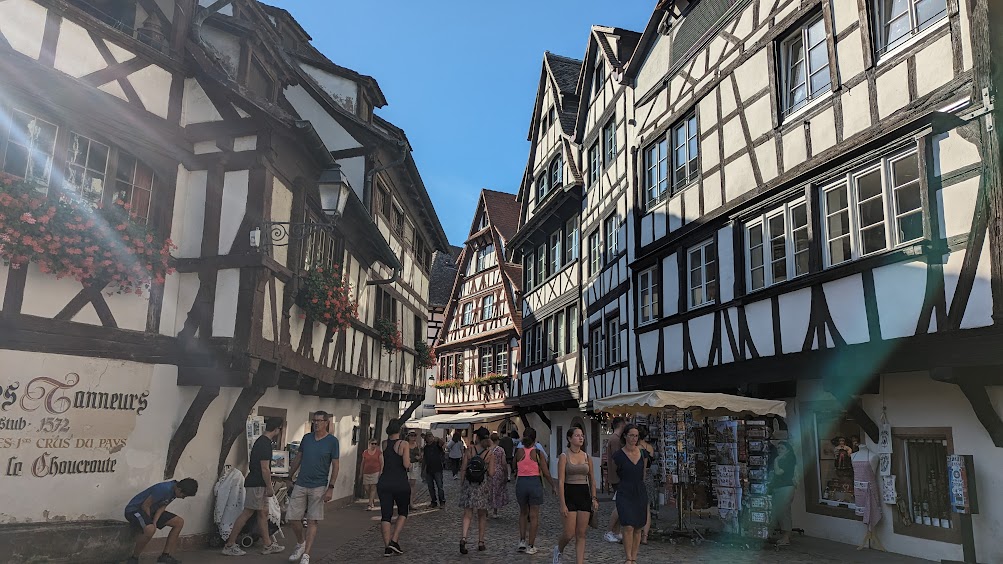
That’s when we come to Place Gutenberg, which provides an entranceway toward the Cathedral. At the center, there is an impressive monument to Johannes Gutenberg, the German inventor of moveable type. Brian tells us that it is said Gutenberg got his inspiration for the printing press from the wine presses he saw when he lived in Strasbourg. (I learn more about this when I return to Strasbourg at the end of the cruise and visit the City historical museum.)
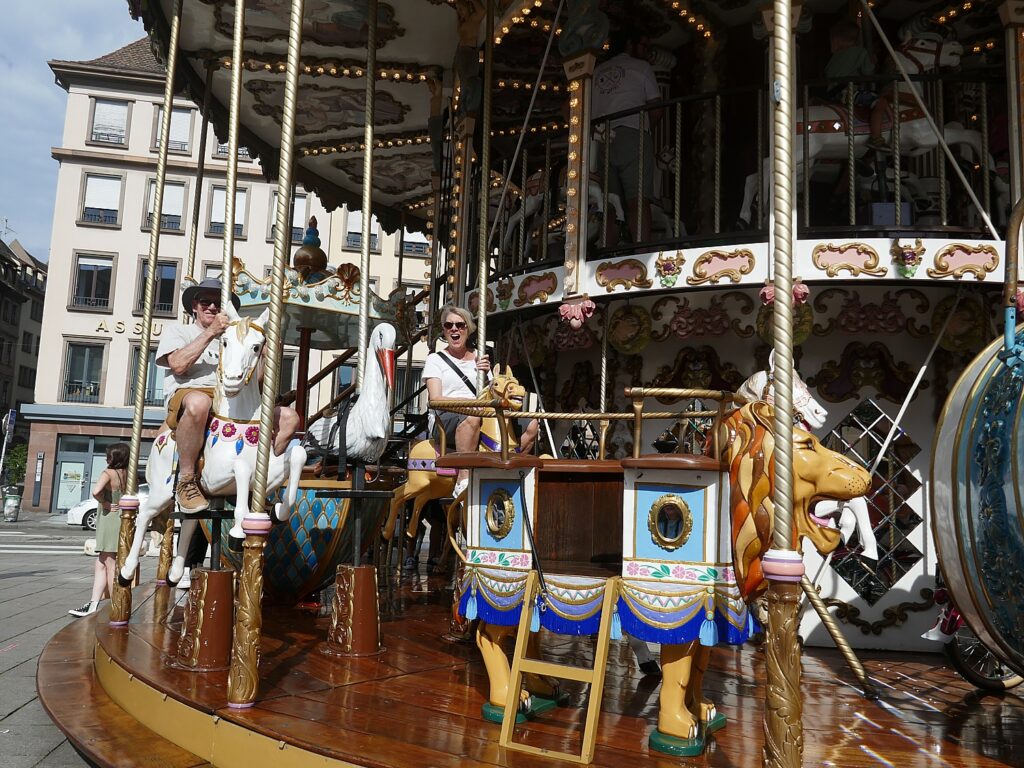
Gutenberg Place also has a marvelous old-timey carousel and since our fellow passengers, Kathy and Marc, are celebrating their 25th anniversary today and Kathy has expressed interest in riding it, we whisper to Marc he should take her for a ride.
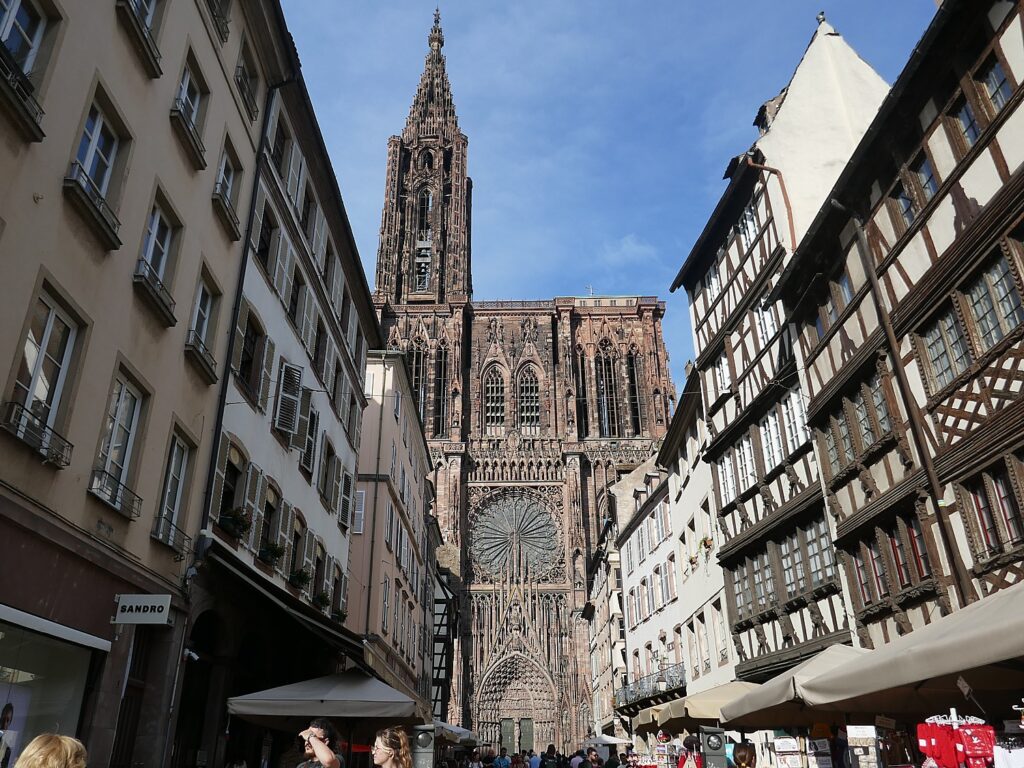
We next walk to Notre-Dame of Strasbourg, a fabulous Cathedral that is considered one of the finest examples of Rayonnant Gothic architecture in Europe, built on a site where a church has stood since the 4-5th century. Construction began in 1015, was relaunched in 1190, and finished in 1439. Erwin von Steinbach, credited as the main architect, worked on it from 1277 until his death in 1318, continued by his son Johannes and his grandson, Gerlach.
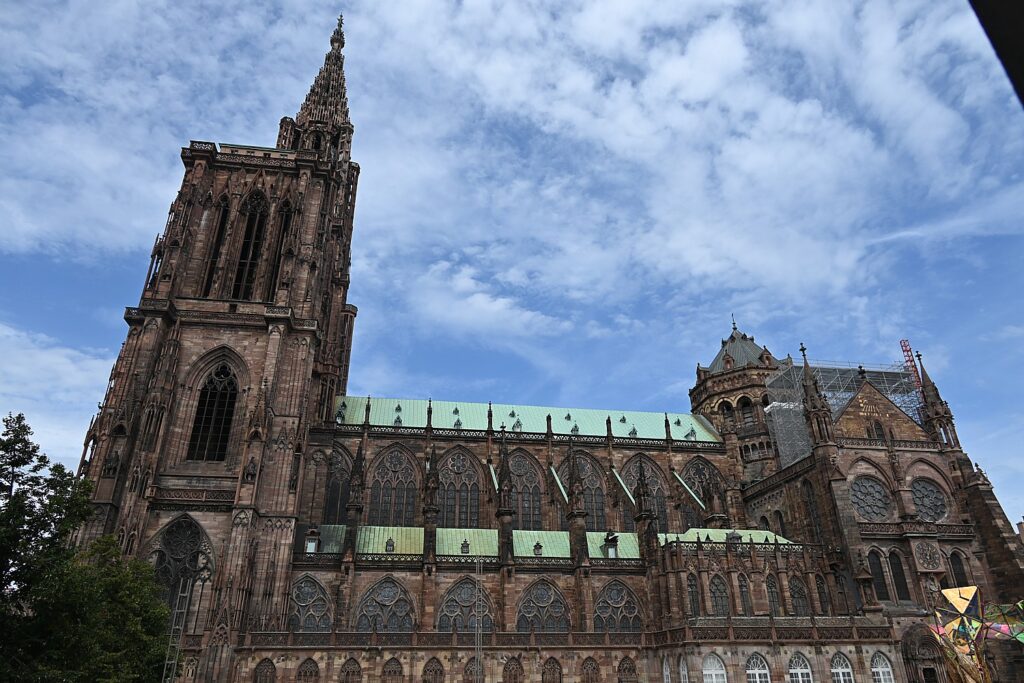
With the bell tower at 142 meters (466 feet) high, Strasbourg’s Cathedral stood as the world’s tallest building for 227 years, from 1647 to 1874. It is still the sixth tallest church in the world, and the tallest structure built entirely in the Middle Ages. It was visible across Alsace, as far off as the Black Forest and the Vosges Mountains, from which the reddish-brown sandstone that gives the cathedral its distinctive color was quarried.
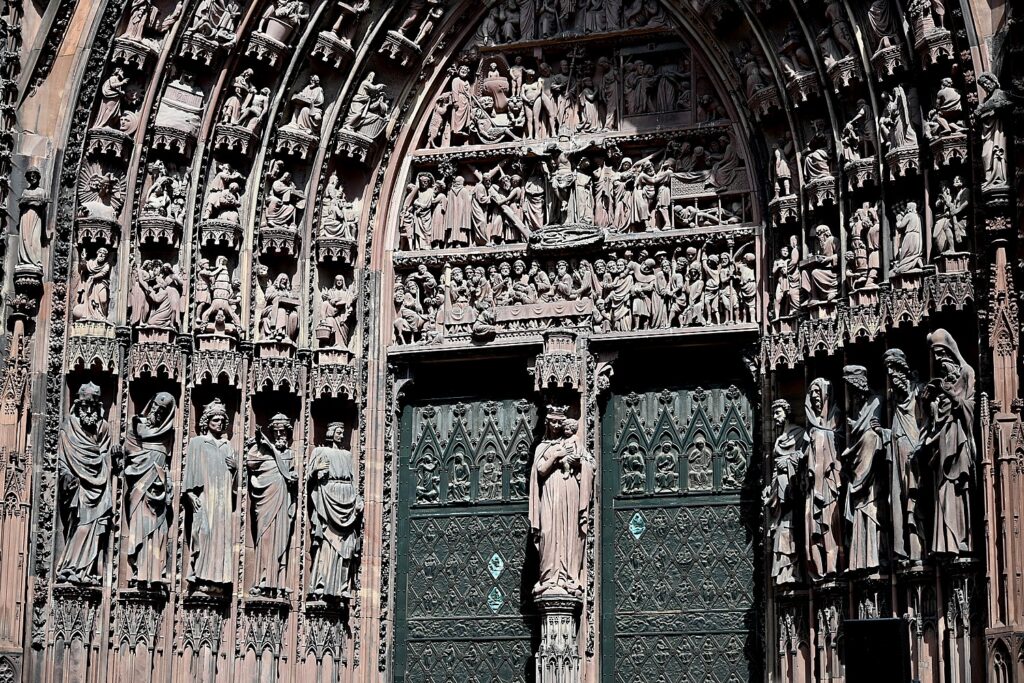
Spectacularly decorated with 300 statutes on the outside and two towering spires supported by two huge pillars it is a study in Gothic flamboyance.
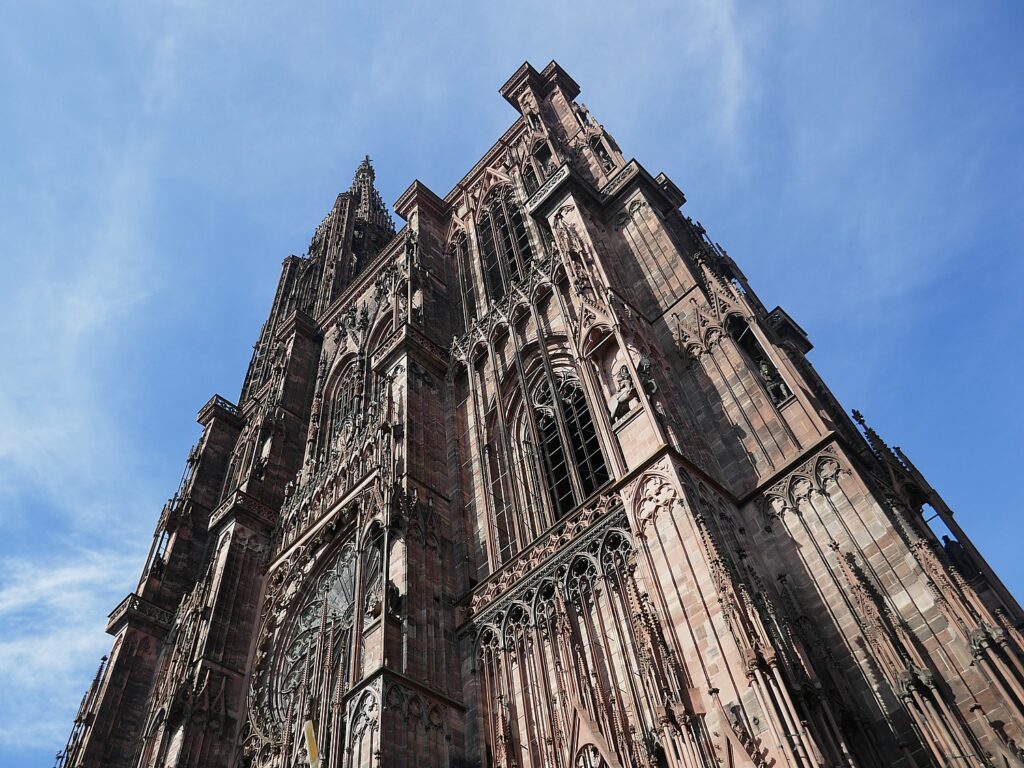
The major attractions of the Cathedral include the Astronomical Clock, a Renaissance masterpiece, and its stained glass windows.
The Musee de L’Oeurvre Notre-Dame just across the square, which I visited, is where you can see the original statuary and art that decorated the Cathedral.
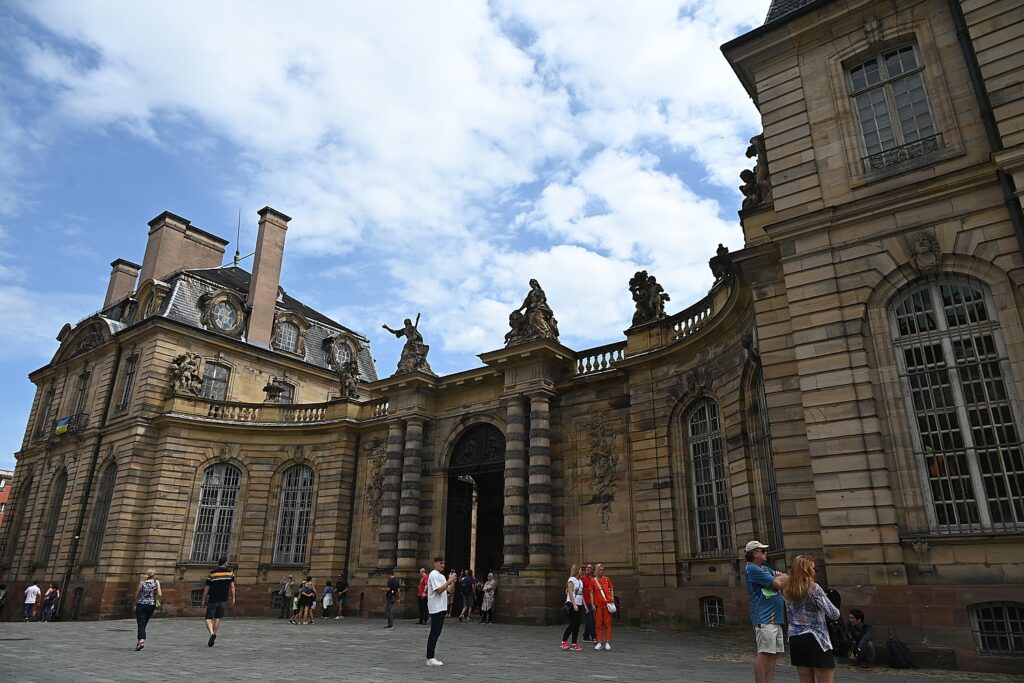
Also across the square – which is a delightfully festive place – there is the Palais Rohan, which Louis XIV built for the Bishop to cement his bond with the Catholic Church. Today it houses three important museums – Fine Arts, Decorative Arts and Archaeology – which I have visited.
We continue to wander on our own, exploring the narrow cobblestone streets, returning to the ship by 7 pm for dinner.
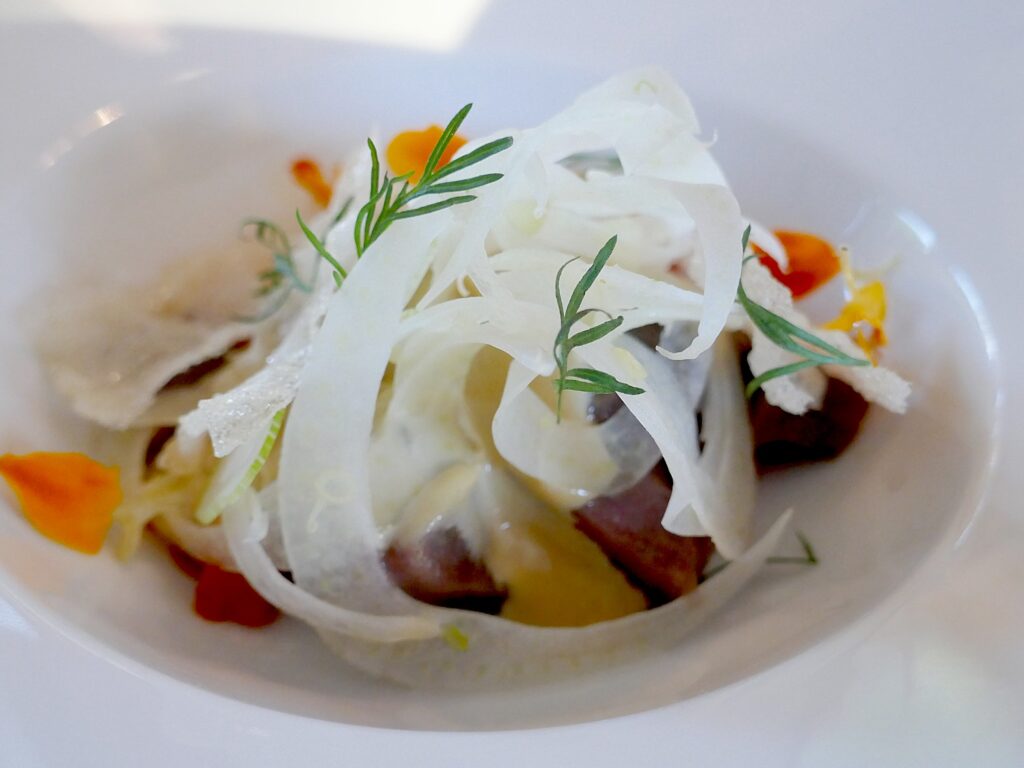
Dinner features tuna tartare with ponzu (a citrus-based sauce commonly used in Japanese cuisine prepared with soy sauce, lime and fennel), served in a rice paper cup with edible flowers (marvelous – so flavorful but not spicey); octopus in black sauce (squid ink), marinated and baked in the oven with eggplant (it took seven hours to cook). The wines are Santenay La Forge (2021) from Cote D’Or; the red is Mercurey, a Bourgogne from Louis Jadot, pairing perfectly with the meal.
The cheeses tonight include the “Queen of Cheese,” Brie de Meaux, “the most popular cheese in the world,” a salty, creamy cow’s milk cheese from Ile-de-France served uncooked and unpressed that you are supposed to hold in your mouth as it melts; Langres, a cow’s milk cheese from Champagne-Ardenne (the rind is designed to be served with Champagne put into a cross hatch on the top which is absorbed and moistens the cheese); and Selles-sur-Cher,a goat’s milk cheese from the Loire Valley, which is dusted with charcoal, to protect and seal the shape, that has a mineral flavor of rind and a briny, tangy center, served with honey.
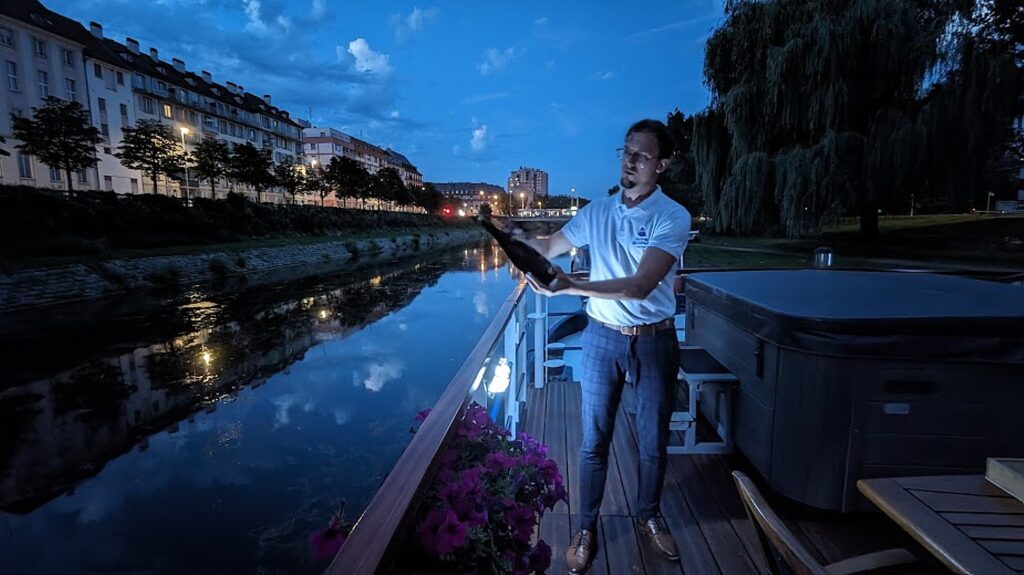
Then, Captain Brian surprises Marc and Kathy with a ritual to celebrate their 25th anniversary – he removes a saber from a box and shows Marc how to slice open a champagne bottle. Then we toast the couple with Champagne. Marc is far more thrilled with this anniversary gesture than riding the carousel.
We overnight in Strasbourg.
Day 3 Strasbourg to Waltenheim-sur-Zorn
While still moored in Strasbourg this morning, we are taken on a scenic drive into the rolling Vosges hills on La Route des Vins d’Alsace, the oldest wine route in France.
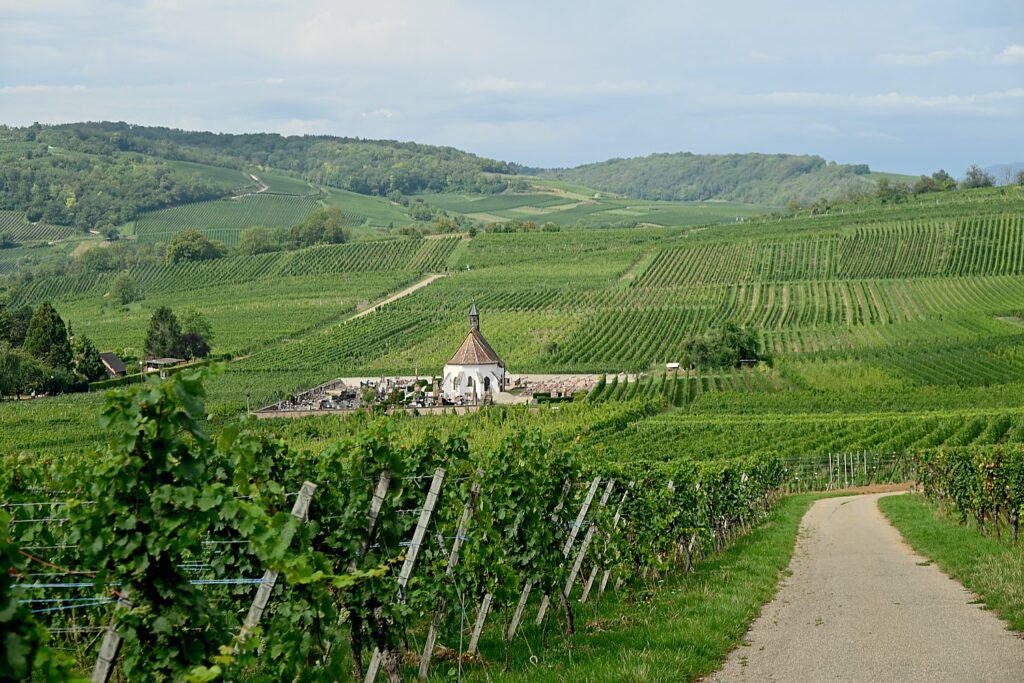
Instead of visiting a conventional vineyard and winery, Captain Brian takes us to Domaine Lissner in the village of Wolxheim to meet a renegade, a true maverick: Bruno Schloegel is on a self-appointed mission to prove how wine can be and should be produced truly naturally, truly sustainably, to protect the environment and the planet.
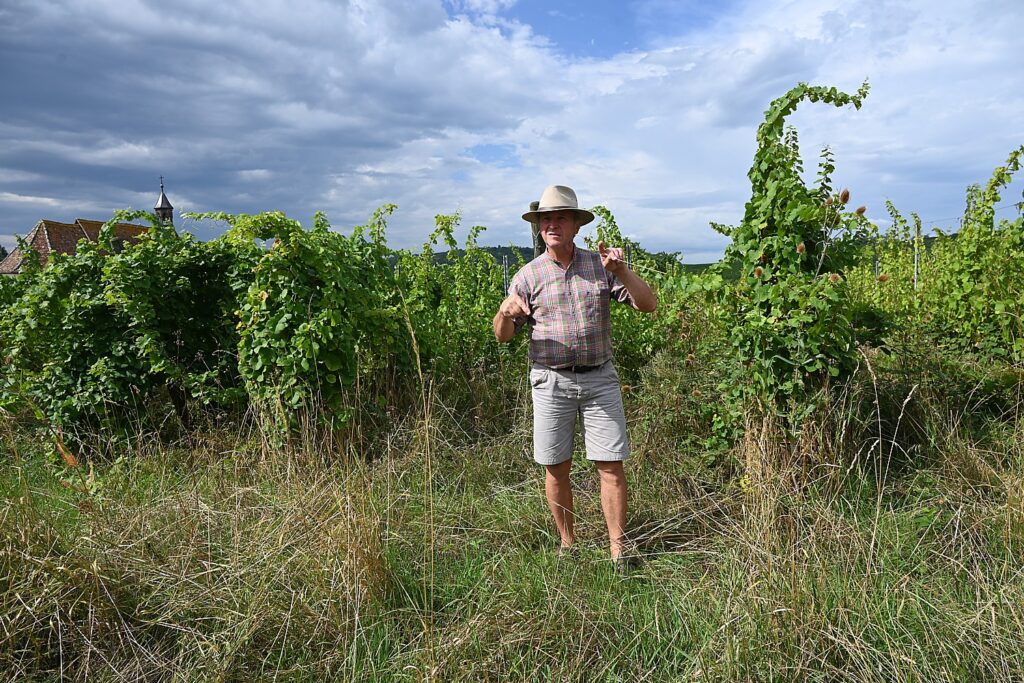
Bruno’s neighbors were not happy (and thought him fou) – his vineyard, which he took over in 2001 from his Uncle Clement Lissner, is a wild tangle of vines in contrast to their manicured rows of pruned vines – but some have come around. He acknowledges his yields are not as great, but it costs him a fraction to operate because he doesn’t use any machinery, any extra energy, or any irrigation or pumps, and spends less on labor. He estimates he saves 600 man-hours of work and some E60,000.

Bruno, who was a university professor and sociologist, has a deep reverence for the past and a deep concern for the future. Vines have been cultivated here since the 7th century, his family has been here since the 17th century, and this vineyard has been in his family for generations. Wine stock, he tells us, can last 800 years. “I had to imagine 2-3 generations from now,” he tells us. “I am responsible to the next generation; these vines link us from the past to the future. We have to find new ways to live in nature.”
Since taking over the vineyard, he has spent the past 22 years “rebuilding the chains of life – the birds, insects and what is under soil. It is a complex approach. I want to take you in our world, our way of thinking. Our wines are living wines- the result of animals, plants – living systems” served non-filtered. “We had to wait up to 10 years for the soil to be alive. We didn’t plant, didn’t treat, don’t put pressure on the wine stock.”
It took that long for the natural plants, animals, insects to come back and for the soil to be rejuvenated. He depends on the birds, spiders, insects, lizards to maintain the ecosystem. “If you would have to invent this machine (a lizard) to wait for fly – it would cost a lot,” he half-jokes. He stresses the importance of biodiversity, “each place another world.”
Manicured vineyards, Bruno insists, masks poor soil. “They are not close to a living system. They are ‘slave’ to the plow. What are we doing to the planet?” In contrast, “We don’t disturb the living cycle.”

He acknowledges that this was an experiment in geological behavior, but insists, “Natural methods produce more resilient vines,” and he will be in much better shape to meet the inevitable challenges of climate change. (Researchers estimate that as much as 70 percent of the world’s wine regions will become too warm this century, including as much as 90 percent of wine’s best traditional regions in Spain, Italy, Greece and Southern California.)
“Energy is not cheap – especially with climate change,” he says. “But even if the climate changes, our system will adapt. We have to find new ways – with this experiment, I can say it works.”
Sounding a bit like a Buddhist monk of winemaking, he says, “More is sometimes less. They cut from the human, machine point of view, not the vine’s point of view” and speaks of “happy vines” free to live their own cycle. “I listen to the wine stock. I let the birds have first growth of grape.” He shows us a plant at the head of a row that presents like a natural cup for birds to drink so they don’t come to vines.
“We regard the vines like a relationship with a living being. We used to have this relationship. It’s a good way to renew the relationship in next century.”
“A harvest is like a wedding – a high moment. We prepare the bride for wedding – we cut only what is dangerous, prune just to make it safe. He says constantly trimming the leaves, prevents the vines from reaching the end of their natural cycle. “There is a time when the leaves should stop growing, so all the energy of the plant goes to grape. But what they do is cut leaves just to make sugar.”
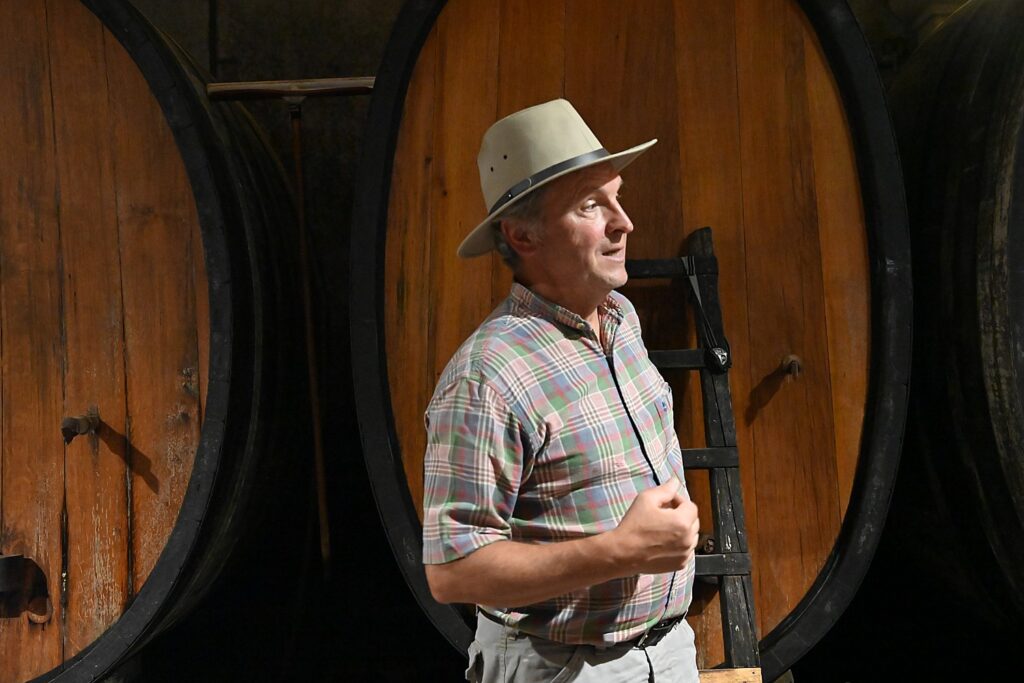
From the field, he takes us next into his wine cellar. He spent four years designing it, another year to find an architect and 40 pages of plans to build a sustainable system that relied on gravity and natural temperature control without the aid of machines or external energy. “We wanted a vertical effluent process to let yeast ferment the juice. The old system had too many steps.”
Back in his tasting room, we get to sample a dozen of his wines.
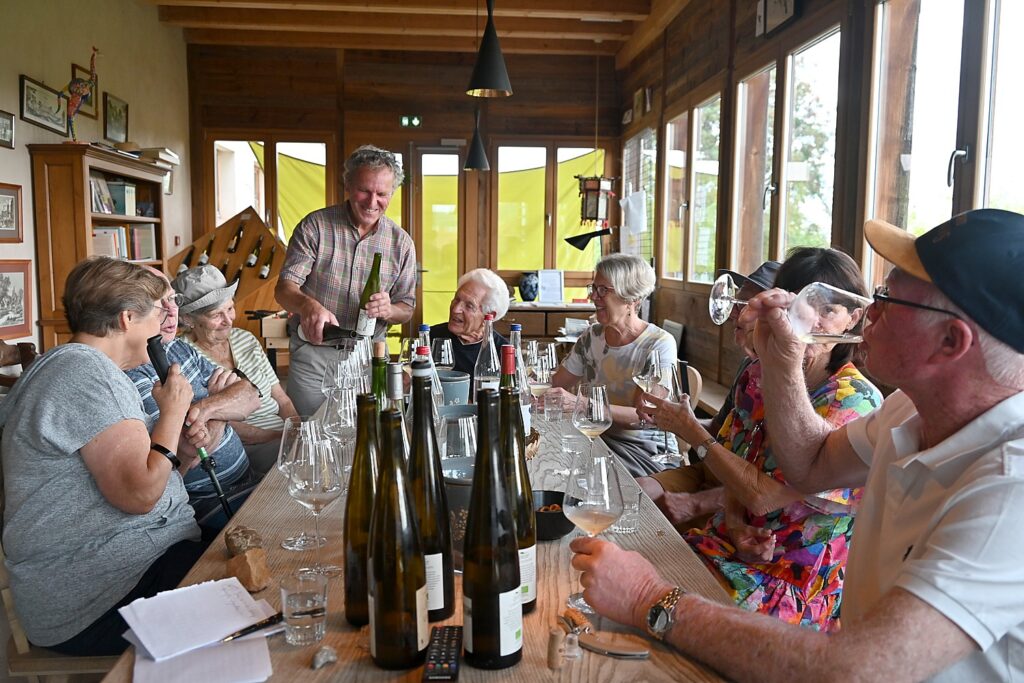
We drive back to the Panache where lunch is being served: a cold black tomato and cucumber soup; spinach and cheese quiche; smoked salmon, horseradish; marinated seabass; strawberry and goat cheese, and chocolate mousse. The wine includes Chateau Aspras, LesTrois Freres, the third generation family winery; a premiere Rose (2022) from Cotes de Provence, a lovely light wine so suited for lunch.
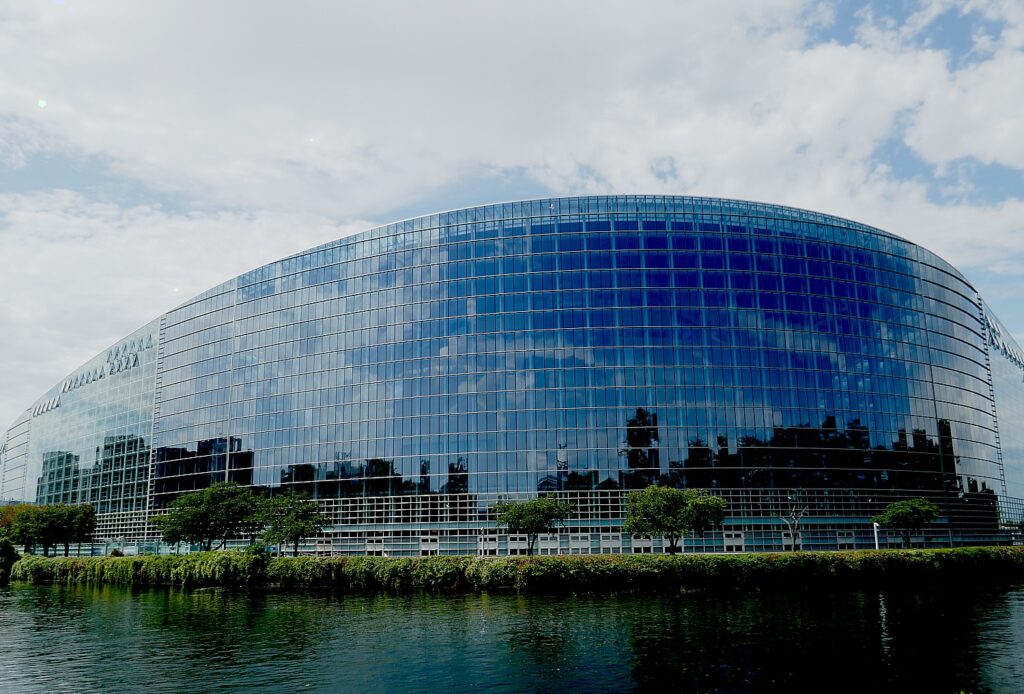
We pull away from our mooring in Strasbourg to continue cruising, taking us passed the impressive European Parliament building on the outskirts of Strasbourg and on through the Brumath Forest to the picturesque village of Waltenheim-sur-Zorn.
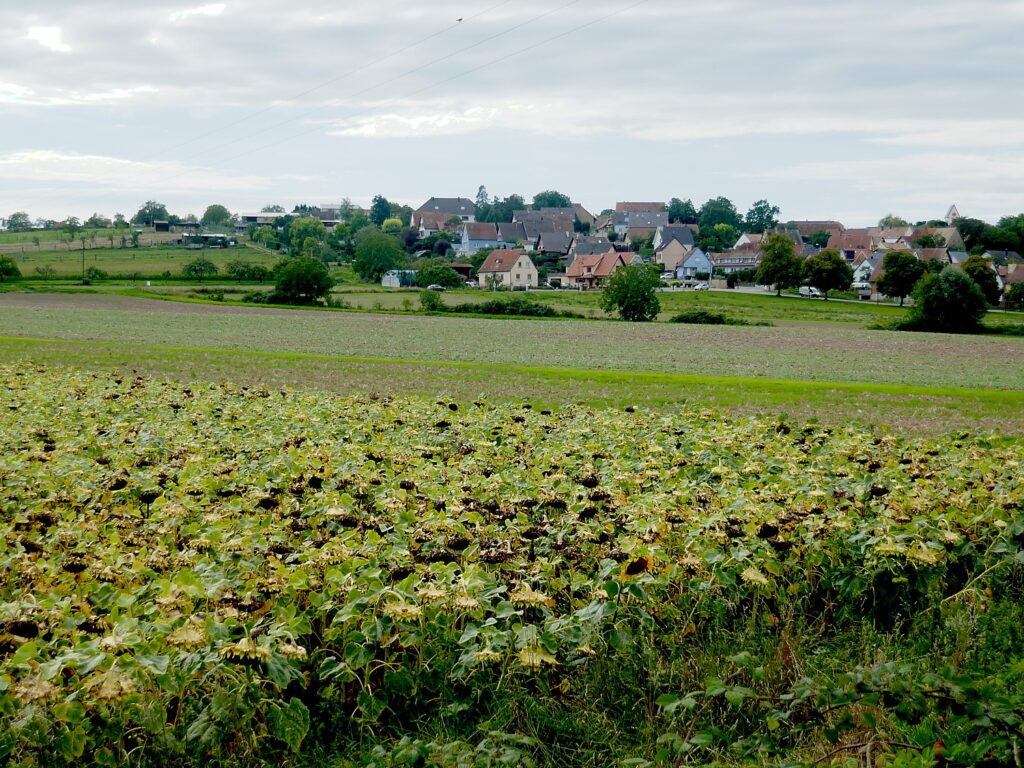
I bike from Lock 51 to 44 (it takes just a half hour), back and forth, thrilled by the pastoral landscapes.
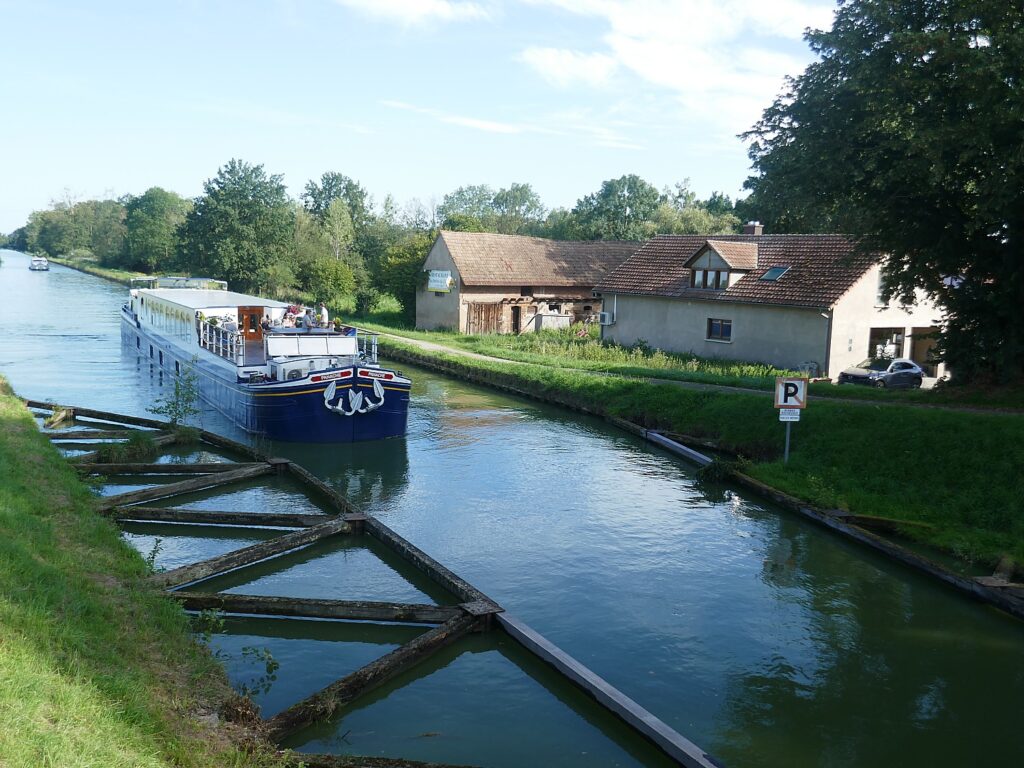
Tonight’s dinner is in a charming restaurant in the village, A L’Eoile, which, though very good, cannot compare with Chef Leo’s creations – clearly we have been spoiled in just these few days. We also get a view to local life – a 70th birthday celebration is going on and the dancing line carries into the street.
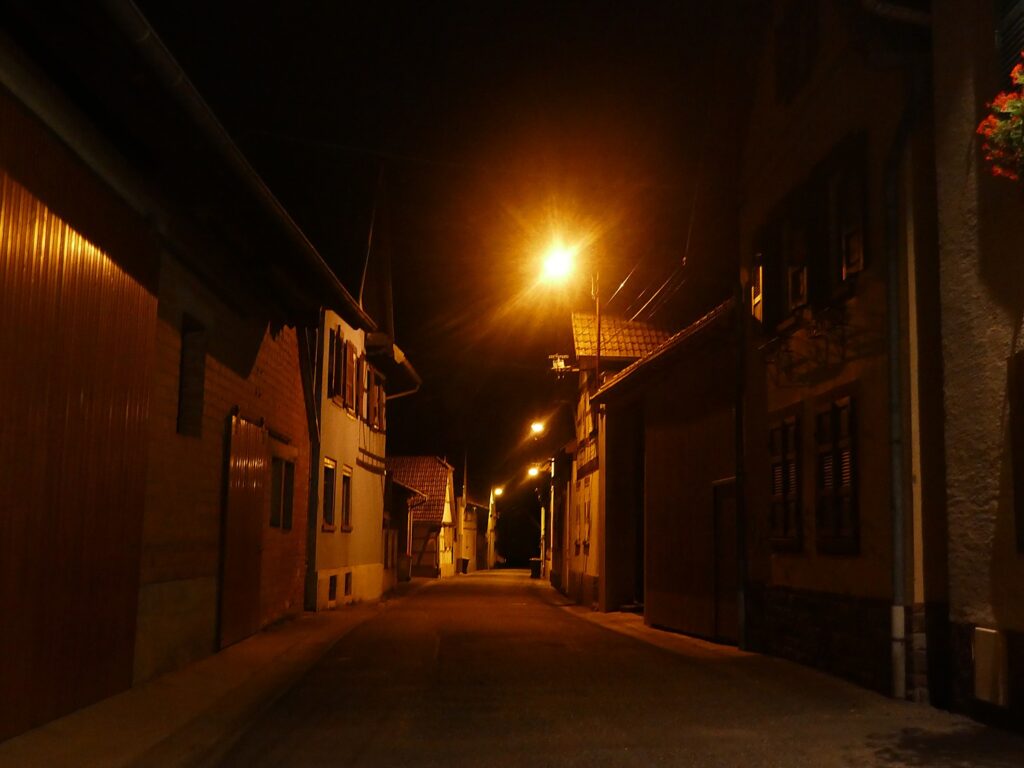
As we have already seen, the Alsace-Lorraine is fiercely French, but the German heritage (having occupied the region multiple times) cannot be denied – in architecture, in cooking, in language.
It is as Bruno said, The Alsace-Lorraine region has a culture that is an inescapably a melding of French and German – “still in the way of thinking, drinking, growing, living together”.
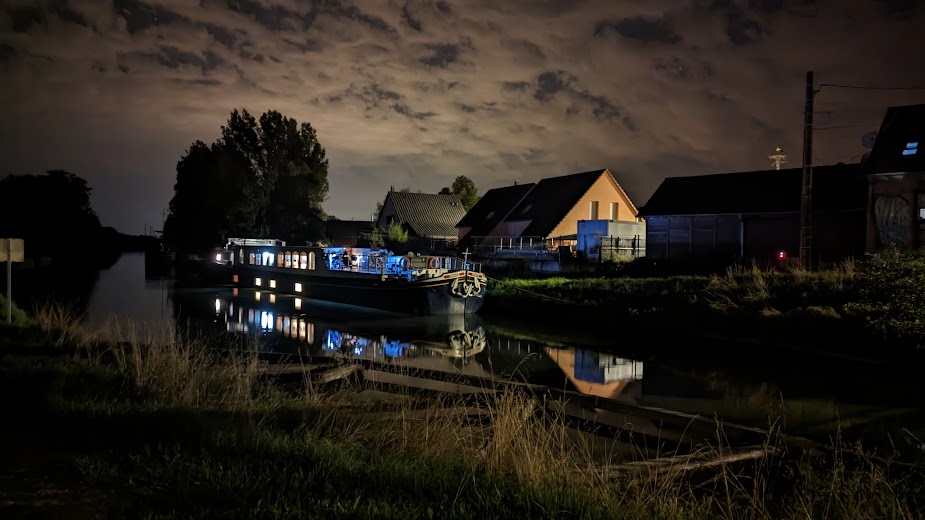
A few of us go for a walk in the night – the view of the boat on the canal is breathtaking.
European Waterways, 1-877-879-8808, www.europeanwaterways.com.
See also:
EUROPEAN WATERWAYS’ PANACHE HOTEL BARGE CRUISES FRANCE’S ALSACE-LORRAINE CANALS IN LUXURY
Next: 3 Musketeers Intrigue in Saverne, Lalique in Lutzelbourg
_______________________
© 2024 Travel Features Syndicate, a division of Workstyles, Inc. All rights reserved. Visit goingplacesfarandnear.com and travelwritersmagazine.com/TravelFeaturesSyndicate/. Blogging at goingplacesnearandfar.wordpress.com and moralcompasstravel.info. Visit instagram.com/going_places_far_and_near and instagram.com/bigbackpacktraveler/ Send comments or questions to FamTravLtr@aol.com. Tweet @TravelFeatures. ‘Like’ us at facebook.com/NewsPhotoFeatures






